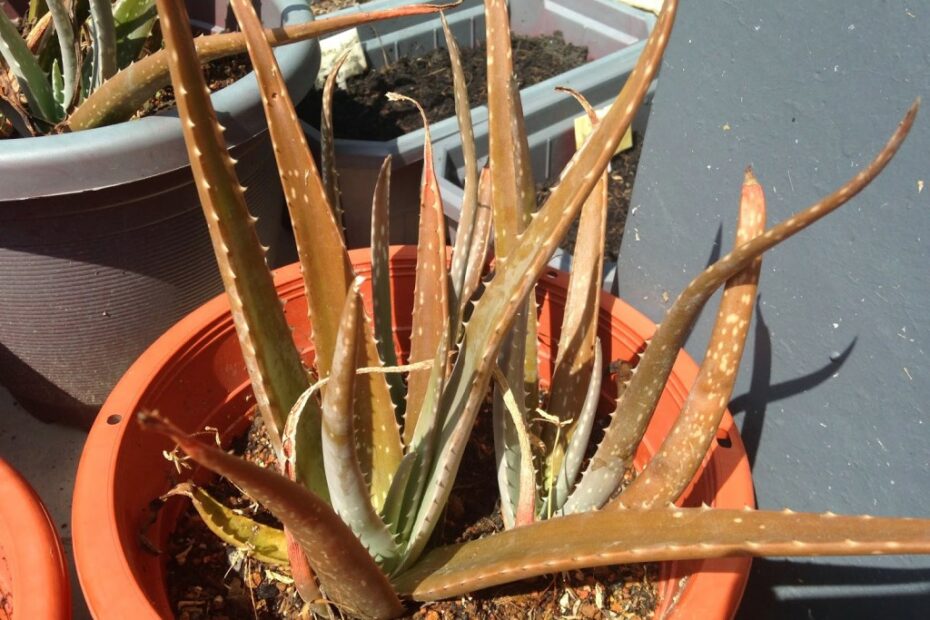Aloe plants are a popular choice for indoor and outdoor gardening due to their low maintenance and numerous health benefits. However, sometimes aloe plants can develop issues, such as turning brown. In this article, we will discuss the possible causes of browning in aloe plants and how to prevent and fix it.
Overwatering
One of the most common reasons for browning in aloe plants is overwatering. Aloe plants prefer well-draining soil and infrequent watering. When the soil is consistently wet, the roots of the plant can become waterlogged and begin to rot, leading to browning.
Underwatering
On the other hand, underwatering can also cause browning in aloe plants. Aloe plants prefer to be kept in dry soil, but they still need a moderate amount of water to survive. If the soil is too dry, the leaves will begin to turn brown and dry out.
Exposure to Direct Sunlight
Aloe plants prefer bright, indirect light. Direct sunlight can cause the leaves of the plant to become sunburned and turn brown. To prevent this, place the plant in a location where it will receive bright light but not direct sunlight.
Pest Infestation
Pests such as mealybugs, spider mites, and scale insects can also cause browning in aloe plants. These pests feed on the sap of the plant and can cause the leaves to turn brown and dry out. To prevent and treat pest infestations, use a pesticide that is safe for use on succulent plants.
Disease
Certain diseases can also cause browning in aloe plants. For example, aloe vera leaf spot is a fungal disease that causes brown spots on the leaves of the plant. To prevent and treat diseases, keep the plant in a clean environment and use a fungicide that is safe for use on succulent plants.
Lack of Nutrients
Aloe plants require a well-balanced diet of nutrients to thrive. If the plant is not getting enough of the essential nutrients it needs, the leaves may begin to turn brown and dry out. To fix this, fertilize the plant with a succulent-specific fertilizer.
Old Age
As aloe plants age, they will naturally start to die off. The leaves will begin to turn brown and dry out, and eventually, the plant will die. There is no way to prevent this from happening.
Temperature
Aloe plants prefer warm temperatures, but they do not tolerate extreme heat or cold. If the temperature in the room where the plant is located is too cold or too hot, the leaves may begin to turn brown and dry out. To prevent this, keep the plant in a room with a temperature between 60-90°F (15-32°C).
Conclusion
Browning in aloe plants can be caused by a variety of factors, including overwatering, underwatering, exposure to direct sunlight, pest infestation, disease, lack of nutrients, old age, and temperature. By understanding the cause of the problem, you can take steps to fix and prevent browning in your aloe plant.
FAQ
Browning in aloe plants can be caused by a variety of factors, including overwatering, underwatering, exposure to direct sunlight, pest infestation, disease, lack of nutrients, old age, and temperature.
Aloe plants have many benefits, including:
– Helping to purify the air by removing toxins and pollutants
– Acting as a natural humidifier by releasing moisture into the air
– Providing a natural source of skin-healing compounds when the gel from the leaves is applied topically
– Acting as a natural remedy for sunburns, cuts and burns
– Being easy to care for and maintain
Aloe plants prefer well-draining soil and infrequent watering. It is best to wait until the soil is completely dry before watering again. In general, it is recommended to water an aloe plant once a week or every two weeks.
Aloe plants prefer bright, indirect light. Direct sunlight can cause the leaves of the plant to become sunburned and turn brown. To prevent this, place the plant in a location where it will receive bright light but not direct sunlight.
